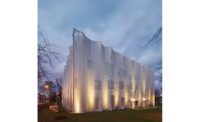K20 Art Collection North Rhine-Westphalia






Architects & Firms
D'sseldorf, Germany
The K20 Art Collection in Düsseldorf is home of one of Germany’s most important contemporary art collections. When the State Chancellery of North Rhine-Westphalia decided to update and expand its original 1986 home two years ago, the administrators tapped the architects of the existing museum, the late Arne Jacobsen’s Copenhagen-based Dissing+Weitling. As they had to shutter the facility to execute the renovation and 21,528-square-foot addition, they also called upon the Bonn-based lighting design firm Licht Kunst Licht to overhaul the dated lighting system.
With numerous museums in their portfolio, Licht Kunst Licht principal Andreas Schulz and lighting designer Alexander Rotsch were accustomed to the demands of illuminating light-sensitive works of art that require shadow-free viewing. Their solution here integrates the architecture and lighting throughout the old and new buildings, seamlessly blending daylight and electric light — fluorescent and halogen — with the structural elements and other mechanical functions, such as ventilation and fire safety.
The lighting designers re-created the original lobby fixtures in a satiny PMMA, a transparent glass substitute also known as acrylic glass, using the same elongated oval motif. To upgrade the lamping, they combined T5 fluorescent tubes for diffuse light and low-pressure halogen — both dimmable — for direct downlighting. The lamp types can be used individually or in tandem as desired. By comparison, existing Arne Jacobsen fixtures along the main stair off the lobby, while beautiful, still emit an old-fashioned dingy, yellowish glow.
The lighting revisions in the existing galleries are equally discreet, but vastly improved. Licht Kunst Licht refabricated approximately 950 ceiling “sails” in polyethylene terephthalate (PET), a category B1 fire-resistant plastic. To satisfy the varying illumination requirements of the installed works, Schulz and Rotsch backlit the sails with both daylight from a series of existing skylights and newly installed luminaires. The new linear fixtures feature a special asymmetrical cove reflector fitted with T5 lamps in museum color-rendering quality. Adjustable louvers on the fenestration manage the amount of sunlight entering through the curves of the diffuse ceiling surface into the space.
In the new wing, the first-floor galleries are lined with 3-phase tracks containing adapted projector luminaires generating illuminance levels from 50 to 300 lux, and equipped with a variety of lenses that control the beam spread. The tracks are integrated with air-conditioning vents and an art-suspension system able to support up to 331 pounds. T5s recessed in coves around the handrails guide visitors up the stairs to the second-floor gallery, where the tracks reappear. Here, however, the lighting designers took advantage of north-facing, shedlike roof windows to configure alternate rows of “luminous” membrane ceilings between the tracks. Similar to the sail-like ceilings in the old building, these are backlit with daylight and reflector-fitted luminaires that use the same museum-quality T5 lamps. Made of low-iron-oxide frosted glass (for good color rendition), the operable windows above the plenum have two layers of remote-controlled shades (in varying opacity) to diffuse the sun’s rays as needed. The actual transparent membrane ceiling comprises 42 panels — half of which automatically lower while the roof windows open, as part of a smoke- and heat-exhaust system designed to protect the gallery’s precious contents in the event of fire.
The fusion of natural and man-made light not only produces a visually comfortable and vital space within which to view art. The shading systems and diffuse ceiling materials also protect the art from damaging ultraviolet rays, and over large portions of the year, the electric backup lighting is often not needed. Additionally, says Rotsch, “We used high-efficiency sources. Even the halogen is infrared-coated, and we tried to reduce the number of different lamps in order to keep maintenance costs down.”
The K20 Art Collection reopened to the public on July 10 with a flexible lighting system capable of bathing the State of North Rhine-Westphalia’s growing compendium of works with effective, shielded light, as well as tackling the challenges of a public facility in the 21st century.
PeopleArchitect: Project architect: Architect of record Associate architect(s) Lighting: Project lighting designers: Photographer(s): CAD system, project management, or other software used: |
ProductsLighting: Downlights: Custom luminaires: Task lighting: Track lighting: Ceiling sails (existing building): Exterior: ERCO Leuchten GmbH Insta Elektro GmbH Franz Sill GmbH Dimming System or other lighting controls: |







